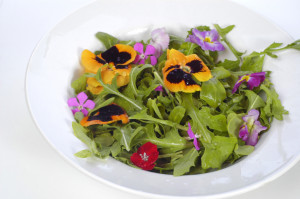 Flowers have been creeping into our diet probably before we realized, and can be traced as far back as Roman times. But if you have green thumbs and are perplexed as what to do with your herbs and greens when they start to seed, it’s as simple as eating them!
Flowers have been creeping into our diet probably before we realized, and can be traced as far back as Roman times. But if you have green thumbs and are perplexed as what to do with your herbs and greens when they start to seed, it’s as simple as eating them!
Arugula flowers have a nutty flavor and can be quite tasty when paired with a simple, elegant dish. One key aspect when cooking with edible flowers is to keep the rest of the herbs and spices to a minimum. Many edible florals have a distinct taste and when combined with too many other flavors, it can be overwhelming.
Cilantro blooms into white flowers that have a milder taste than the herb itself. The flowers are a great addition to garnishes, salad, and lighter vegetable dishes. You should be sure to use the flowers raw however as the flavor fades when it is cooked.
Basil is another great herb that we use quite regularly, but has flowers that tend to be bright white, pale pink or lavender. Like cilantro, the flavor of the basil flower is milder and should be sprinkled over salads or pasta dishes.
Sage has a beautiful violet, pink, or white flower that is small and tube-like. The leaves have a stronger taste, but the flowers are great to sauté, add to pesto, or use in salads or garnishes.
No matter what you choose to do with your flora, fauna, and herbs be sure to not eat flowers grown with pesticides. No flowers are safe unless they have been grown organically. For the most part this includes flowers sold at nurseries and anything you see on the side of the road. Be sure to thoroughly wash the flower. Remove the pistils and the stamen if necessary.
-Arianna Schioldager

















